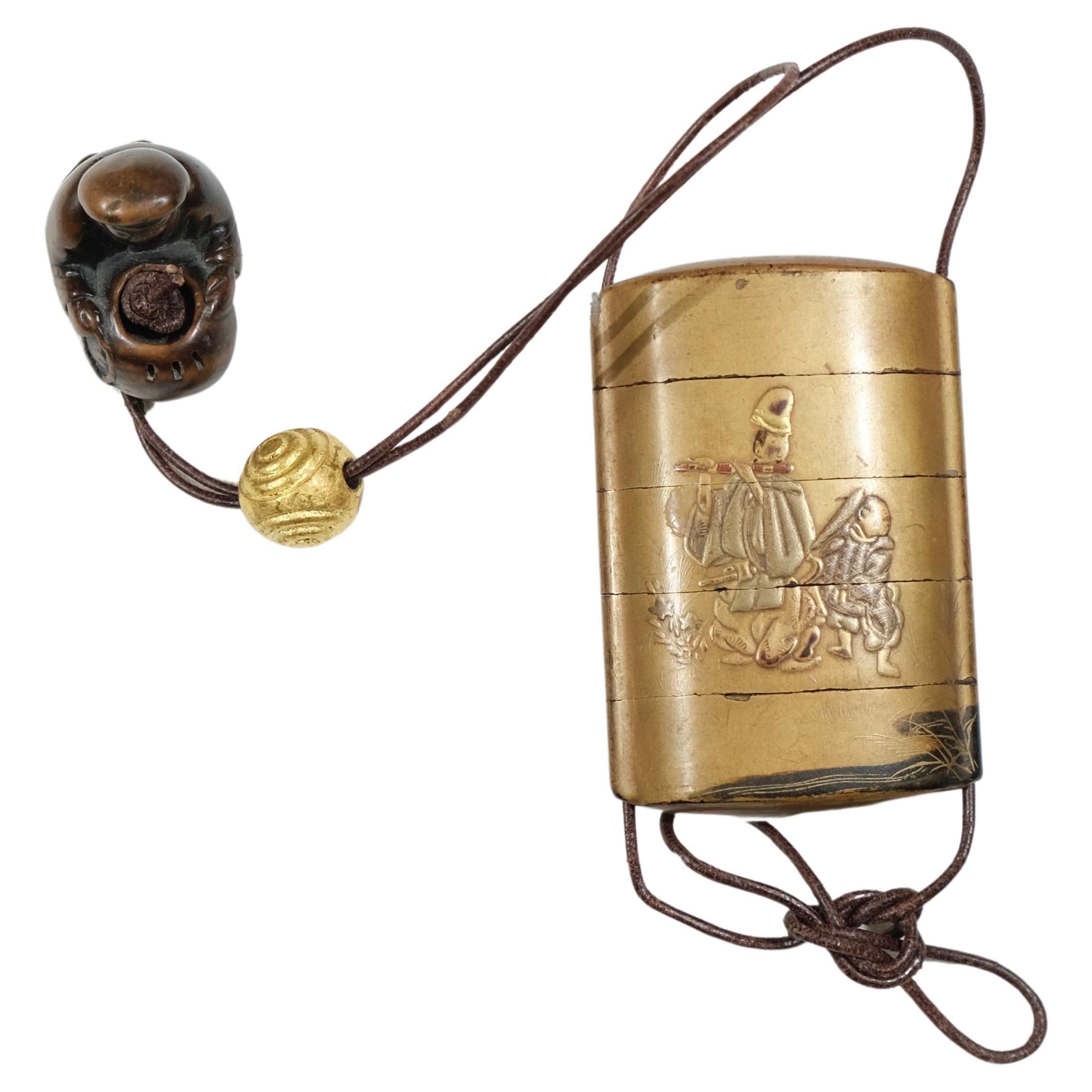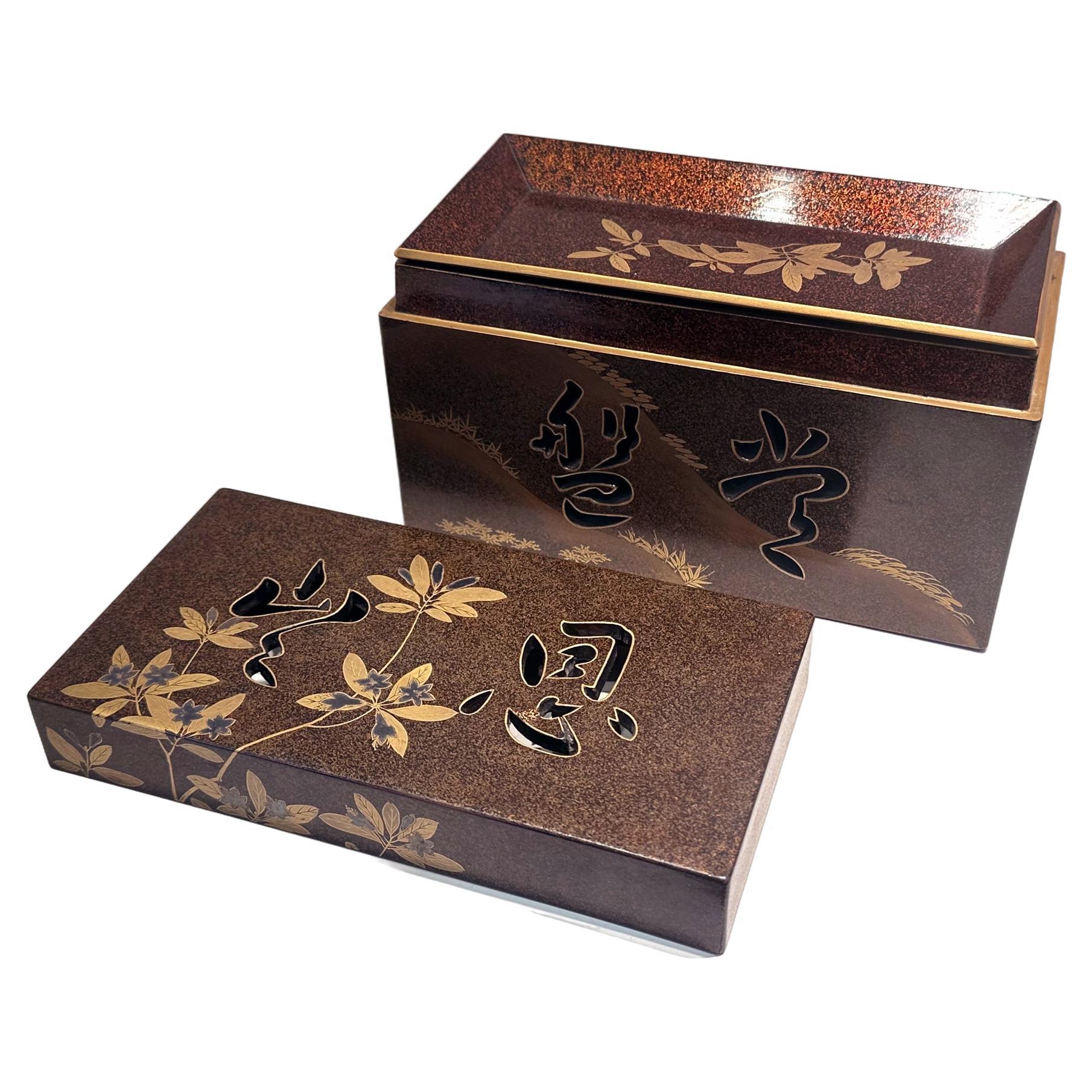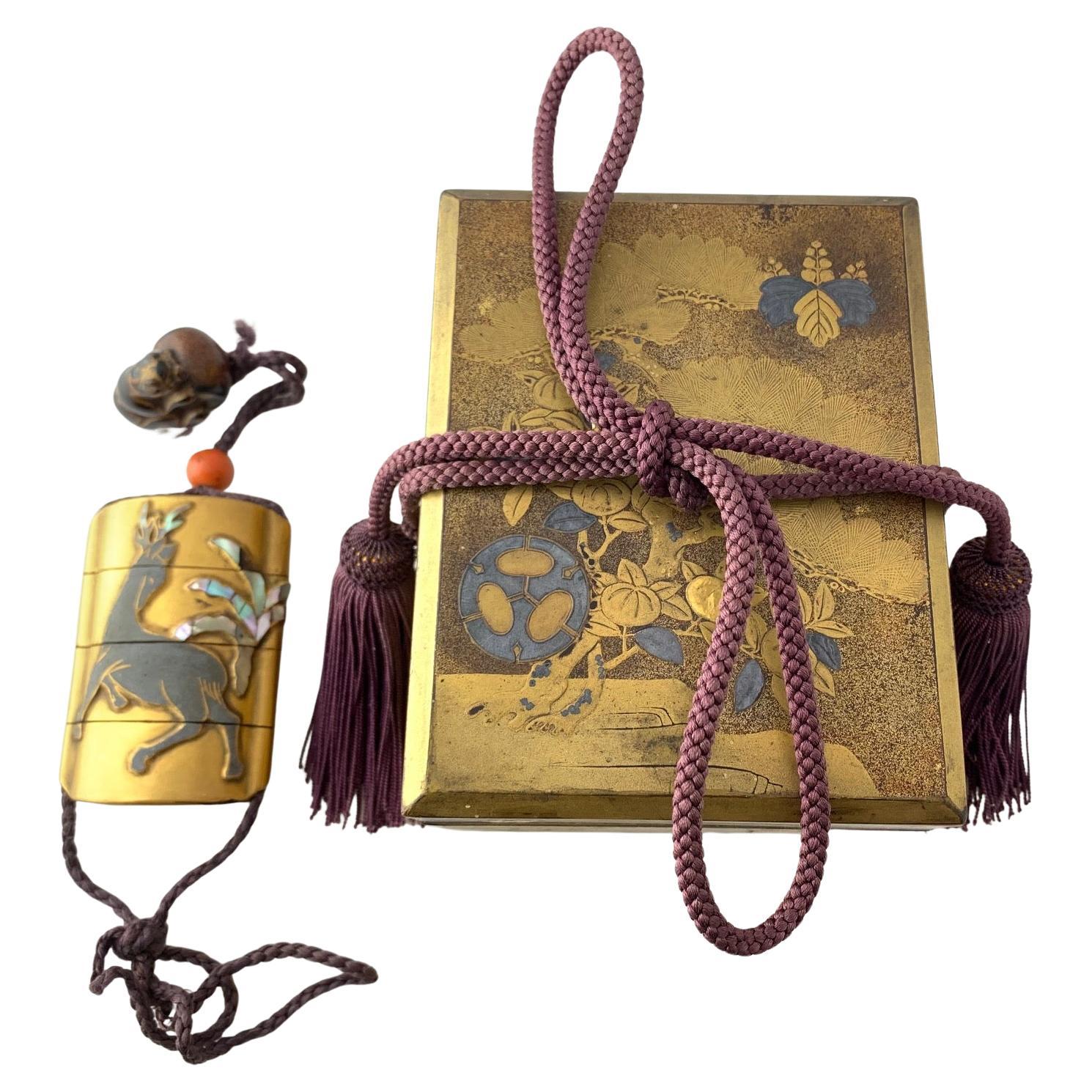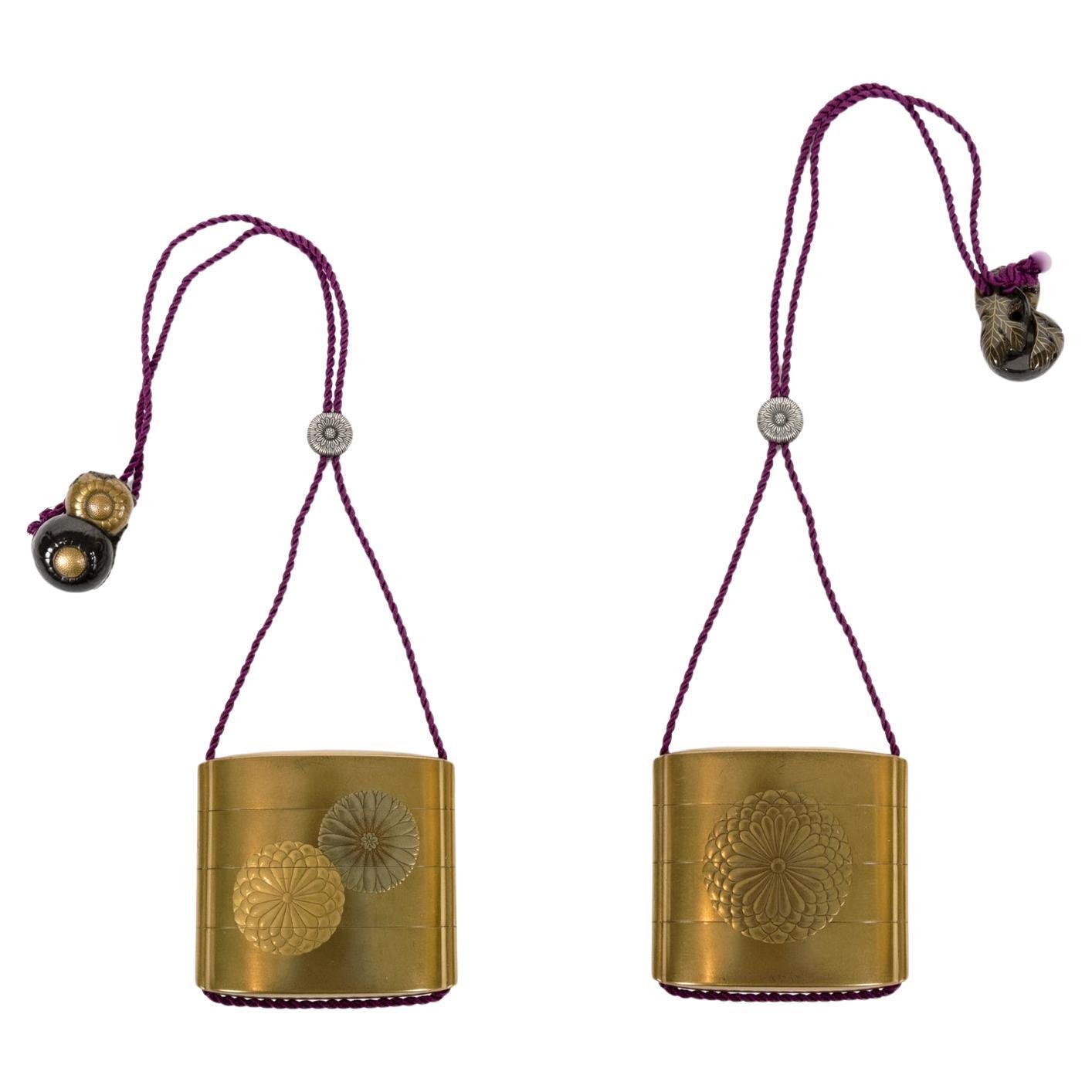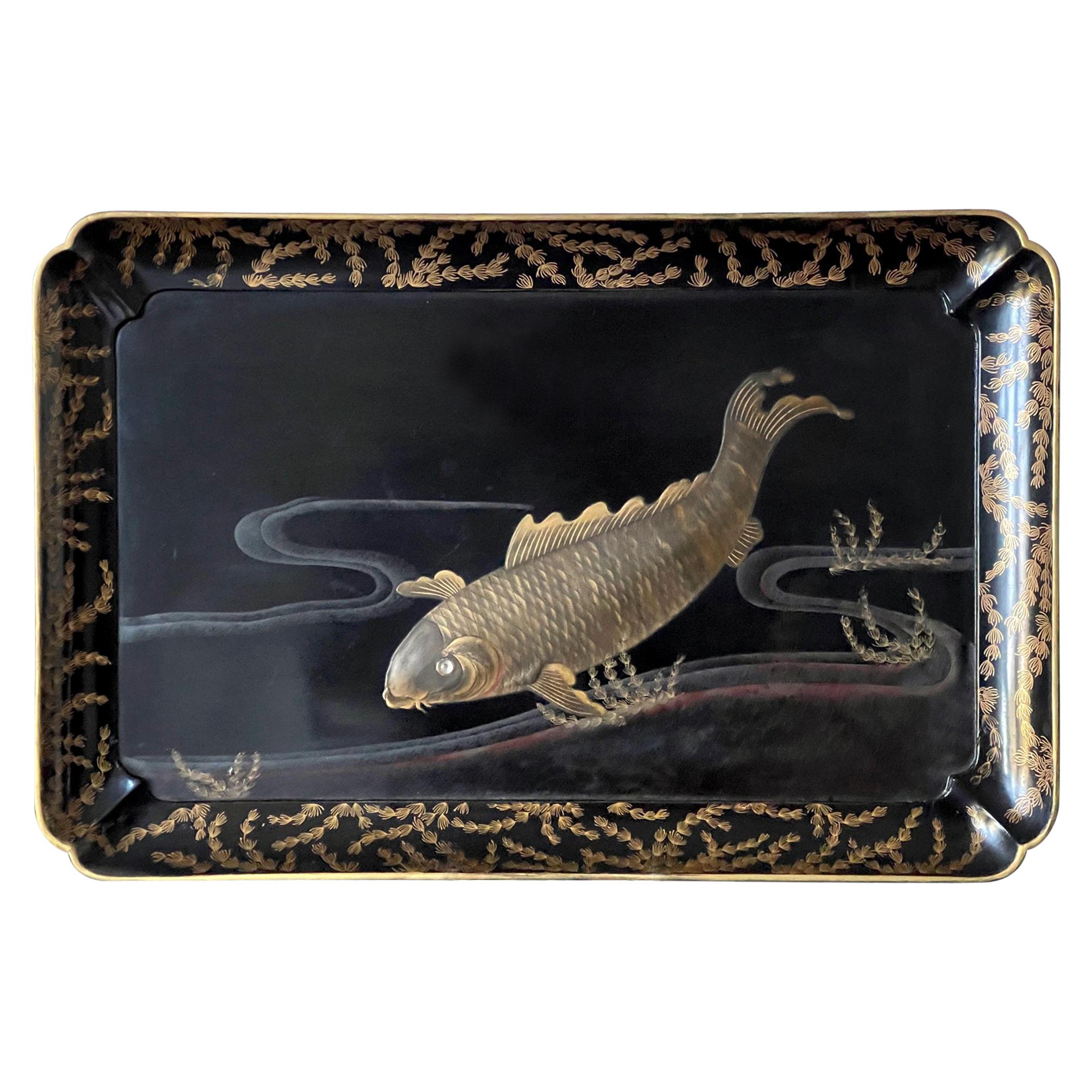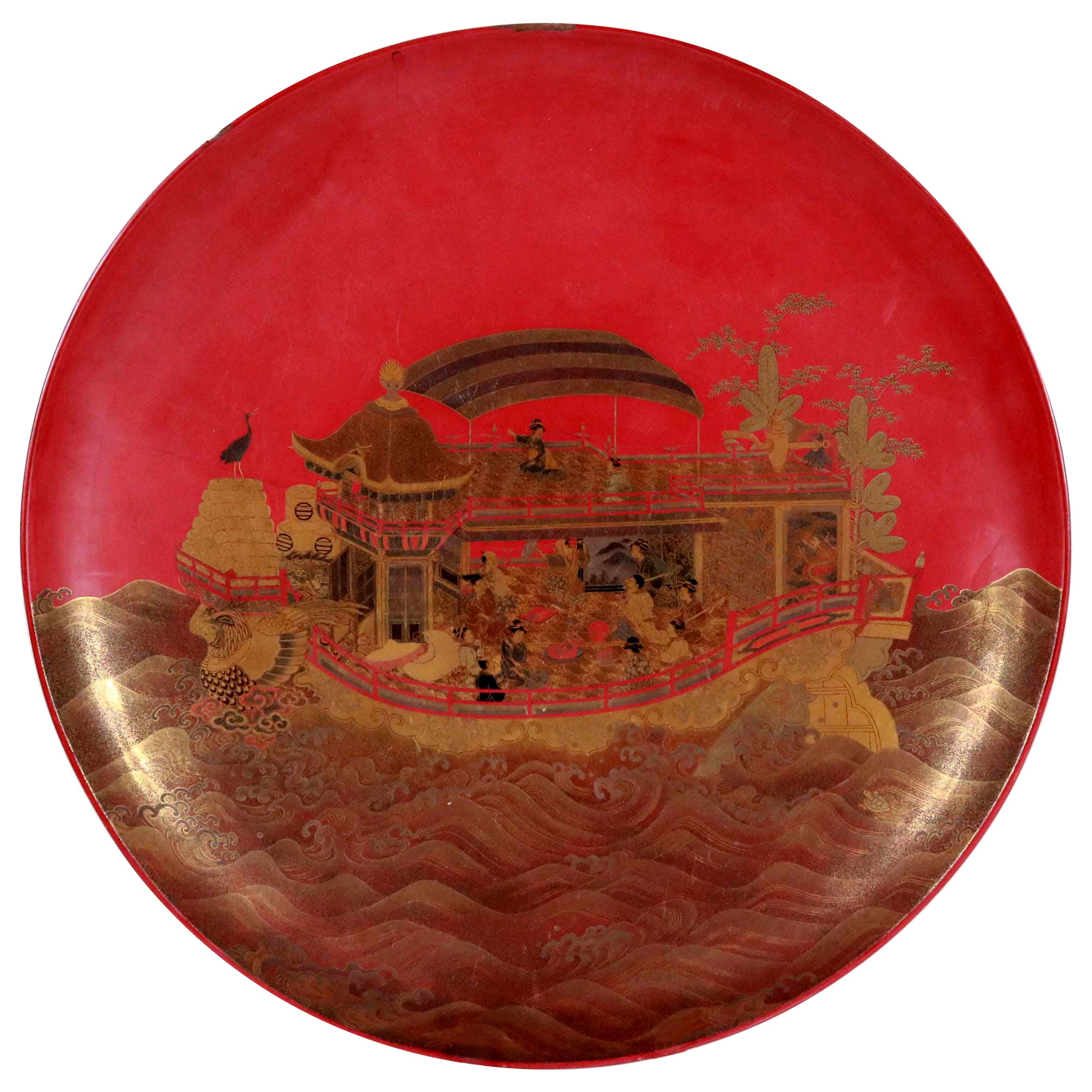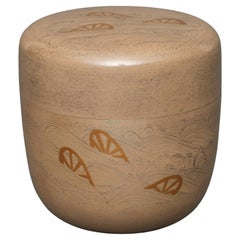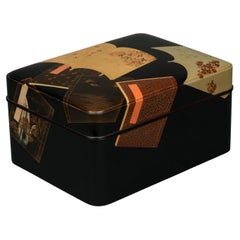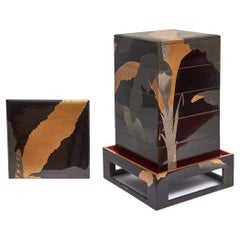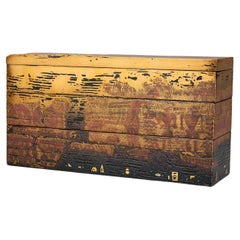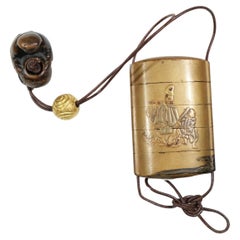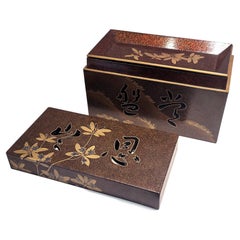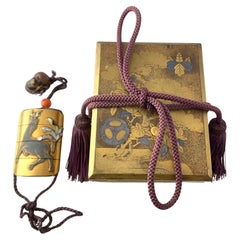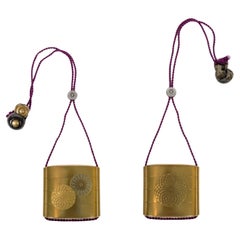Items Similar to Japanese lacquer inrô 印籠 with golden maki-e firefly design with matching netsuke
Want more images or videos?
Request additional images or videos from the seller
1 of 18
Japanese lacquer inrô 印籠 with golden maki-e firefly design with matching netsuke
About the Item
A lacquered 4-piece inrô with a covering design of fireflies (hotaru) flying over helms of grass and around a lantern (andon), shining attractively for the fireflies. Surrounded by rims embellished with a scrolling vine design (karakusa).
Executed in golden hiramaki-e (low-relief lacquer design) and takamaki-e (high-relief lacquer design) with small red accents on the wings and kirigane, (cut and inlaid pieces of gold leaf) at the tails of the fireflies to accentuate the ‘light’ they exude. Set on a glossy black lacquer background.
The compartmentalized interior coated with nashiji (sprinkled gold lacquer)finished with fundame rims (matt gold lacquer).
Laced with purple silk cords, with a brown glass bead ojime, and 2-part manjû netsuke showcasing, on both sides, a herd of oxen at a winding river.
Signed at the bottom of the inrô: ‘Yôyûsai’ with kao. After the 18th century lacquer artist Hara Yôyûsai, but not by his hand.
Dimensions:
Inrô:
Height 3.14 in/8.0 cm, Width 2.44 in/6.2 cm, Depth 1.02 in/2.6 cm.
Ojime:
Diameter 0.62 in/1.6 cm.
Netsuke:
Diameter 1.49 in/3.8 cm, Depth 0.59 in/1.5 cm.
When shipped we will add a certificate of authenticity.
Price including insured shipping.
- Dimensions:Height: 3.15 in (8 cm)Width: 2.45 in (6.2 cm)Depth: 1.03 in (2.6 cm)
- Materials and Techniques:
- Place of Origin:
- Period:
- Date of Manufacture:Meiji period (1868-1912)
- Condition:Wear consistent with age and use. Minor losses. In very good original condition with some signs of wear conform age. Please see the photos for reference to its condition.
- Seller Location:Amsterdam, NL
- Reference Number:Seller: B45761stDibs: LU7165237235252
About the Seller
4.8
Vetted Professional Seller
Every seller passes strict standards for authenticity and reliability
Established in 1996
1stDibs seller since 2022
22 sales on 1stDibs
Typical response time: Several days
- ShippingRetrieving quote...Shipping from: Zwanenburg, Netherlands
- Return Policy
Authenticity Guarantee
In the unlikely event there’s an issue with an item’s authenticity, contact us within 1 year for a full refund. DetailsMoney-Back Guarantee
If your item is not as described, is damaged in transit, or does not arrive, contact us within 7 days for a full refund. Details24-Hour Cancellation
You have a 24-hour grace period in which to reconsider your purchase, with no questions asked.Vetted Professional Sellers
Our world-class sellers must adhere to strict standards for service and quality, maintaining the integrity of our listings.Price-Match Guarantee
If you find that a seller listed the same item for a lower price elsewhere, we’ll match it.Trusted Global Delivery
Our best-in-class carrier network provides specialized shipping options worldwide, including custom delivery.More From This Seller
View AllJapanese Ecru Lacquered Natsume 棗 'Tea Caddy' with Maki-E of Carriage Wheels
Located in Amsterdam, NL
Uncommon ecru lacquer tea caddy (natsume) with a nice golden hiramaki-e (low-relief design) of cart wheels submerged in a wild swirling stream.
The design...
Category
20th Century Japanese Lacquer
Materials
Giltwood, Lacquer
Japanese lacquer tebako 手箱 (box for personal accessories) with book design
Located in Amsterdam, NL
Superb rectangular black lacquer tebako (box for personal accessories) with a slightly domed well-fitted lid.
The lid has a continuous soft-tone multicoloured hiramaki-e (low-relief...
Category
Early 20th Century Japanese Lacquer
Materials
Lacquer
Japanese lacquered 5-tiered jûbako 重箱 (picnic box) with banana leaf design
Located in Amsterdam, NL
Elegant lacquered tiered jûbako (picnic box) comprising five stackable tiers, two covers, and a raised tray. Each bearing an attractive deep chestnut brown ground and lacquered in ta...
Category
Early 20th Century Japanese Lacquer
Materials
Giltwood, Lacquer
Japanese lacquer oblong storage box by Hiroshi Hayashi 林宏 (1967)
By Hiroshi Hayashi
Located in Amsterdam, NL
An exceptional, oblong lacquer 3-tiered storage box with cover, reminiscent of a bento box, by Hiroshi Hayashi (1967). Covered in shiny gold and black l...
Category
21st Century and Contemporary Japanese Lacquer
Materials
Silk, Wood, Lacquer
Japanese Lacquer Suzuribako 硯箱 'Writing Box' by Hattori Toshio 服部俊夫 '1943'
By Hattori Toshio (Shunsho)
Located in Amsterdam, NL
A small Japanese black and gold lacquer suzuribako (writing box) with cartwheels in water, by the artist Hattori Toshio (1943).
Of rectangular form with rounded corners, bearing a lustrous rôiro ground throughout, the exterior sides of the box and exterior of the cover finely decorated in gold and little silver takamaki-e with cartwheels flowing in a dynamically executed body of water with many swirls
and gushes as well as scattered dew drops, the interior tray fitted with a rectangular ink stone and silver suiteki (waterdropper).
The underside signed ‘Toshi’.
With the original wooden tomobako with hakogaki reading Namikuruma makie suzuribako (The
writing box set, with a design of wheels in water), as well as a leaflet written in Japanese with the artist’s biography up to 1987.
Hattori Toshio (b. 1943), art name Hattori Shunsho, was first selected for the Nitten exhibition in Showa 38 (1963). Since then, he has exhibited more than twenty times at the Nitten and other exhibitions, winning numerous prestigious awards. In 1995,
he had an audience with Pope John Paul II and presented the Pope with a lacquer reading table. In 2004, he created the shelves for the guest room of the Kyoto State Guest House of the Government of Japan. He is a member of the Kyoto Crafts Artists Association, the Kyoto Lacquer...
Category
Late 20th Century Japanese Lacquer
Materials
Wood, Giltwood, Lacquer
Rare set of 2 Japanese suits-of-armour, complete with 2 matching folding screens
Located in Amsterdam, NL
Important unique set of two suits-of-armour (yoroi), complete with two high six-panel screens, that belong together as is indicated by the used family crests (mon). Two crests are used, both belonging to the Nakagawa family of Oka Castle, Ôita prefecture on Kyûshû.
They are:
– the Nakagawa-kurusu, a circle depicting a Celtic-like cross through a ring.
The cross was originally a Christian symbol but after the ban on Christianity in Japan the use of a hidden cross in family crests could continue.
– the Nakagawa-kashiwa, two leaves of the Japanese Emperor Oak turned to each other (dakikashiwa mon).
The remarkable aspect of this ensemble is the presence of matching crests on both the yoroi and the accompanying folding screens. The kurusu and kashiwa crests adorning the yoroi are elegantly replicated on the screens, providing compelling evidence that these pieces form a harmonious and unified set. This exceptional cohesion between the armour and screens further enhances their artistic and historical value.
After the warlord Toyotomi Hideyoshi (1537-1598) had interfered in the battle between the Lord of Bungo Province Ôtomo Yoshi-mune (1558-1605) and the Shimazu of Hyûga Province, he split the Bungo Province in a number of small fiefs and transferred in 1594 Nakagawa Hideshige (1570-1612) from Miki Castle
in the Harima Fief to Oka Castle in Kyûshû.
The Nakagawa family stayed in possession of Oka Castle till the abolishment of the military use of castles in 1873. In 1884 the Nakagawa family received the title of Count (a title in use till the abolishment of aristocracy in 1947).
After the Nakagawa’s left, the castle and the building soon dilapidated and is now known as Oka Castle Ruins. The castle is located in Taketa Village part of Taketa Town in Ôita Province on Kyûshû.
> Set of two tall byôbu (folding screens),
painted with large red jinmaku (camp enclosure curtain) on a gold leaf ground. The curtains show both crests of the Nakagawa family: one screen depicts two Nakagawa-kurusu crests next to a Nakagawa-kashi crest in the middle, and the other shows the symbols the other way round.
Dimensions:
Total width 148.66 in/377.6 cm (2 x 25.35 in/64.4 cm, 4 x 24.48 in/62.2 cm); Height 72.63 in/184.5 cm.
Period: Japan – Late Edo period (First half 19th century), and maybe even older.
> Yoroi with Nakagawa-kashiwa crest:
A Japanese black lacquered suit-of-armour (yoroi) completely laced with orange cords (kuro’urushinuri hi’ito odoshi nimai’dô’maru).
A thirty-two plate suji’bachi kabuto (helmet with raised ridges) with in front a maedate (fore crest) -with traces of gilding- in the shape of flames, resembling a mythical flaming bird flying down. The fukikaeshi (face guards) and the mabizashi (visor) have the Nakagawa-kashiwa crest in gold maki-e lacquer.
Five curved ‘itazane’-plate neck guards (shikoro) laced with orange cords.
Together with an ‘angry man...
Category
Antique 18th Century Japanese Antiquities
Materials
Metal, Iron, Gold Leaf
You May Also Like
A fivepart Japanese lacquer inro with netsuke, late 19th c.
Located in Stockholm, SE
A nicely designed Japanese lacquer Inro with a wooden netsuke. The Inro with motives of a man playing a flute on one side and a creek on the other side. The Netsuke with signature.
Category
Antique Late 19th Century Japanese Lacquer
Materials
Lacquer
Japanese Maki-e Lacquer Tray Box with Cutout Design
Located in Atlanta, GA
A Japanese lacquer box with lid and an inner tray decorated with Maki-e on a dense nashiji background. The fine box was likely made circa 1920-30s...
Category
Vintage 1920s Japanese Taisho Lacquer
Materials
Wood, Lacquer
Japanese Gold Lacquer Inro with Deer Image, Ojime, Wood Frog Netsuke, Makie Box
Located in Point Richmond, CA
The Inro is comprised of three stacked compartments and features a deer motif with mother of pearl accents, an ojime and a wooden frog netsuke. Inros were used to store items like m...
Category
Antique 1890s Japanese Meiji Lacquer
Materials
Wood, Lacquer
Japanese lacquered Inro chrysantemum
Located in PARIS, FR
Beautifull Inro of three compartments made in kinji lacquer with an hiro maki-e
ornament chrysanthemum flowers of gold and silver lacquer. Inside is in fundame
lacquer.
Signed by J...
Category
Antique Mid-18th Century Japanese Lacquer
Materials
Lacquer
Large Japanese Lacquer Tray with Maki-e Carp Design Meiji Period
Located in Atlanta, GA
A large rectangular tray with scalloped corners and slightly raised gallery rim circa late 19th century to early 20th century (end of Meiji period). The center image showcases a live...
Category
Early 20th Century Japanese Japonisme Lacquer
Materials
Lacquer
Large Japanese Lacquer Plate with Elaborate Maki-e Design by Kajikawa
Located in Atlanta, GA
A large circular plate with a short stem base in Vermillion lacquer color. The surface was decorated with a stunning maki-e picture that depicts a...
Category
Antique 19th Century Japanese Japonisme Lacquer
Materials
Lacquer
Recently Viewed
View AllMore Ways To Browse
18th Century Lacquered
Brown Glass Beads
Black Lacquer Gold Leaf
Purple Lacquer
Lantern With Red Glass
Red Lantern Light
18th Century Lace
Netsukes
Lantern Light Japanese
Japanese Netsuke
Purple Glass Beads
Red Antique Lantern
Antique Japanese Lantern
Antique Japanese Lanterns
Japanese Painted Silk Scroll
Embellished Silk Coat
Black Gold Lantern
Japanese Scroll 18th Century
